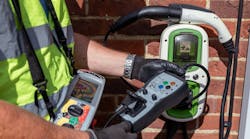EV Chargers: Power Grid Impact and Maintenance Requirements
The growing population of electric vehicles on the road is placing a bigger burden on the ability of the existing power grid to sustain the increased load for charging all of these vehicles. In recent years, a number of events have demonstrated the stressed state the power grid is already under.
The need to charge EVs will only serve to make this situation worse with the plan to drastically increase the number of charging stations. Roughly 47,000 publicly accessible EV charging stations are currently in service across the United States, according to the Department of Energy. The Biden administration has legislation in place to raise this number to a total of 500,000 charging stations.
Pushing the Grid
It is well known that many electrical grids are already being pushed to the limit. For this reason, the same legislation provides plans to improve the electrical infrastructure. Furthermore, the increased load demand from this EV charger population growth will affect utilities in various ways depending on the type of chargers used and the state of the current grid infrastructure. The effect on power quality due to the overall behavior of these chargers is of particular concern.
One example is the harmonic distortion and individual harmonic magnitudes measured while these units are in different operation modes. During on-charge periods, chargers operate within acceptable thresholds where the fundamental current exceeds 50 amps. However, when the units are idle and the fundamental current is very low (less than 2 amps), the harmonic distortion and individual harmonic frequencies surpass recommended thresholds. The presence of excessive harmonics can distort the voltage waveform, thus causing problems in a power system. This becomes a major area of concern when several charging stations are installed at a common point.
Appropriate maintenance, testing, and power quality monitoring are critical to ensure chargers operate properly as well as to negate the additional stress and potential negative impact EV chargers could possibly have on the power grid.
Maintenance Requirements
An electric vehicle charge point must be tested at installation, after repair, and during periodic inspection. The three main elements of testing a charge point are safety, functionality, and performance.
1. Safety — the most important test — determines that a charge point is safe to touch and will automatically disconnect in the event of a fault
2. Functionality testing covers the charger’s ability to recognize that a vehicle is connected and that communication is sent and received correctly.
3. A performance test determines whether the charger can supply the required voltage and current levels with good power quality.
Safety
The three elements to a safety check are the ground fault test, GFCI trip check, and communication error check. A good testing tool will run through each of these tests and provide a pass/fail result.
1. The presence of any voltage on the frame or ground conductors is a problem because it is a direct risk of electric shock. This is the first safety test, and if a voltage is present, this problem must be fixed before any other work is done.
2. Most charge points will have a safety disconnection device such as a ground fault circuit interrupter (GFCI). A good GFCI will protect people and equipment from fault currents. These devices must also be inspected and tested to ensure they don’t trip or disconnect at lower-than-expected settings; this can lead to false tripping (or nuisance tripping).
3. During the charging operation, there is continued communication between the charge point and the EV. If this communication is interrupted for any reason, the charge point must stop supplying power. This is an important safety precaution that any inspection tool must test for and provide a pass/fail result.
Functionality
The function of a charge point is controlled by the communications between the EV and the charge point. Therefore, the primary functionality test is a check of the communication protocols.
The proximity pilot (PP) signal of the charge point must be tested. This is the communication signal that informs the charge point about the presence of an EV.
The control pilot (CP) has several current settings including no current, 13 A, 20 A, 30 A, 50 A, 80 A, and others. This setting determines the maximum current that will be supplied during charging. The CP is an essential piece of communication that allows for the safest and most efficient charging.
It is critical to provide the appropriate power to the connected EV because too much power can damage the EV and too little will not charge it. Additionally, it is best to reduce the amount of current as the EV batteries are charged up because the reduction of charge current as the batteries reach 100% capacity limits overload, heating, and damage.
Another important communication protocol for the control pilot signal is charging status (Figure 2). The CP has various status states: no vehicle connected, EV connected but not ready, EV ready to charge, EV ready to charge with ventilation required, and error.
Electrical testing tools allow electricians to test the full functionality of a charge point and ensure a correct installation.
Performance
Finally, performance testing verifies that the charge point is supplying the power needed and with acceptable quality. This requires a discharge testing unit capable of power quality analysis.
Charge points could vary from high power such as 350 kW to a small residential unit supplying just 0.7 kW, but in all cases, voltage and current output should be verified. A discharge tester is commonly used to test batteries and discharge them onto a known load, but these discharge testers can be also used to test the EV charge point itself. Having a known load that behaves the same way each time allows for accurate determination of any degradation or other problems over time.
Power Analysis
Analyzing power quality (PQ) in terms of harmonics and distortions is also part of good maintenance practice. PQ analysis is done by logging the output current and voltage over time. Good PQ analyzers will automatically detect and report distortions, phase shifts, and harmonics among other parameters. This power verification ensures that customers do get the power they pay for, and the quality analysis helps identify causes of errors and safety disconnections.
Using good testing practice with the right tools is critical to the safe and correct operation of charge points. It is highly recommended that charge points are fully tested at installation and after repair. Most charge points have sensors that send back information to a control center, but a periodic check is still necessary to ensure that the sensor information is correct. Therefore, a periodic charge point check is recommended as part of the maintenance procedure.
More than a million charge points will be installed over the next few years, and they will provide a good revenue stream for commercial owners and utilities. However, they must be correctly installed and maintained well in order to function correctly and safely.Ahmed El-Rasheed, PhD, is an Industry Director at Megger with over 15 years of experience in electrical engineering. Several Megger products have been developed with his leadership over the past 8 years. He is a member of several international standards organizations including IEC and SCC, where he works on committees responsible for many electrical testing standards. He has published papers on ground testing, insulation testing, and multi-sensor integration using AI. Ahmed received his BS, MS, and PhD — specializing in electrical testing, sensor systems, and data processing using artificial intelligence — at the University of Liverpool, UK.
Jason Aaron has been an Applications Engineer with Megger’s Technical Support Group since 2020. He enlisted in the US Marine Corp right after high school and was trained as an aircraft technician. After 10 years of service, he worked for Shermco for 8 years performing start-up, maintenance, and commissioning of electrical power systems and substations while earning Level 4 NETA certification. He is an IEEE member focusing in the areas of circuit breaker primary current injection techniques and cable testing, diagnostics, and fault location.
The InterNational Electrical Testing Association (NETA) was formed in 1972 to establish uniform testing procedures for electrical equipment and systems. Today the association publishes standards for the electrical testing industry, accredits electrical testing companies; certifies electrical testing technicians and publishes the ANSI/NETA Standards for Acceptance Testing, Maintenance Testing, Commissioning, and the Certification of Electrical Test Technicians. NETA also provides training through its annual PowerTest Conference and library of educational resources.




